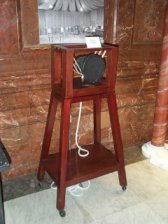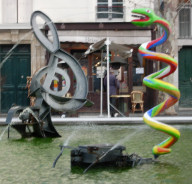Description
Added words in the dialogue to fill in what is 'blind' for the listener
the "There You Are On The Sofa With Your Box Of Chocolates, Irene" Rule
Example from BBC soap, 'The Archers':
FX : (TONY DIGGING, GRUNTING. OUTSIDE ACOUSTIC. SPADE ON EARTH)
PAT: (approaching) Still digging the carrots, Tony?
| Description is mostly of physical details, facial expressions, gestures and bodily action. |
| Description demands skill in scripting. It must not be obstrusive or clunky. |
| Description is often needed at the start of a scene - part of signposting. |
| Some scenes and action demand more description. |
| Description is the 'added extra' in radio drama - what this medium demands as an aural-only medium. |
A typical place for description is at the top of a scene. It often links with signposting.
Some scenes demand more description.
Description can be called the "There You Are On The Sofa With Your Box Of Chocolates, Irene" Rule.
Description as a technique is most distinctive of radio, the invisible or blind medium.
It is a test of the playwright.
It is especially needed to describe physical bearing, movement and gesture, and facial expression.
This might be necessary if one or more of these contradict what the character says. Kind words, for example, hiding suspicion, or politeness masking fear. This psychological complication can be observed often in TV thrillers and police interrogation scenes, where there lurk hidden motives. The TV or film camera does the work. In radio drama, this work has to be done in the script.
Description is a term invented by Alan Beck - and is not established as a term in professional radio drama production.
Description and the 'silent character'
There is a particular technical problem for the playwright, in supplying
description if one of the characters is significantly silent. The other
characters have to supply description of the character's reactions, whether
these are uttered in paralanguage or not.
Anthony Minghella, in 'Cigarettes and Chocolate', constructed a radio play
out of this central situation, the need for description. The female protagonist
stays silent till her finale monologue.
A vivid interactive 'dialogue' with her is created by continuous description, coming from her lover and from her friends. The irony is, of course, that they misread her physical signals. Then the radio listeners, who do not have direct access to these, are let into the truth about her, by her own direct monologue to them.
Comments on description
Rodger, RADIO DRAMA (1982) 10:
Directions as to movement and scene changes must be mostly contained within
the dialogue but they must never be so obvious as to become laughable.
It is also easily said that radio creates its own scenery but this observation
neglects the fact that such creation is in the hands of the writer.
Ditto 151:
(Of music and sound effects) They can usually only succeed when they are
cued by verbal hints and allusions. The hinge relating music and effects
to the dialogue is verbal; it must be so written as not to appear too obvious
and the words employed must be rational and cogent.
Gielgud, THE RIGHT WAY TO RADIO PLAYWRITING (1948) 51:
If any sound effect is essential, then the dialogue must either point forward
to it or refer back to it. This sounds both elementary and clumsy. And
that it should not appear clumsy to either is one of the many tricks which
the radio playwright must make it his business to master.
Felton, THE RADIO-PLAY. ITS TECHNIQUES AND POSSIBILITIES (1949) 45:
(Of sound effects) Their value, and even their identity, depends on what
is established about them in the dialogue or narrative. Imagine you hear
a liquid being poured into a glass: it is whisky, or brandy, or water,
or medicine, according to what the dialogue has led you to expect. Or the
identification may come after the sound.
Felton, Felix, 1949, The Radio-play: its techniques and possibilities, London: Sylvan Press.
Gordon Lea, RADIO DRAMA AND HOW TO WRITE IT (1926) 54:
(He describes this description as part of the "self-contained method".)
58:
Better still indicate action in the dialogue, then reinforce that spoken
indication by sound-effects. Here again, crudity must be avoided. It is
not so difficult as it might seem, to give these indications, but they
must be given naturally, or at least so artistically that they seem natural.
(This is the first book on the technique of radio drama).

Examples of description
In Wally K Daly's 'What's Stigmata?', the stupid character, the deaf father,
has others constantly describe what is happening to him.
In 'The Kingston File', an exciting police thriller scene, the girl
in the police car describes the house siege down the hand-held police car
microphone to headquarters officers.
'Citizens' 25/8/88 - Mike: "Come and sit down on a king-size bed."
Mike to Anita beginning their affair.
Les Smith, 'Some Kind of Hero' Monday Night Play - 20/1/86 - "And
when you turn your back like this, when you refuse to talk - "
Here is some advice about how to use DESCRIPTION with Reverberation (echo)

To WELCOME PAGE
Radio Soap (serial drama) - HOW TO MAKE IT
Five-minute episodes - or short episodes
Step by step instruction from Alan Beck.
Learn about radio drama on this site along with my book - Beck, Alan, Radio Acting, London: A & C Black (1997) ISBN 0-7136-4631-4
This is how to make a short-form soap - entertaining (above all) and you can include issues (issues that could influence the listeners' behaviour).
Further: production, scripting, web site, marketing, focus group meetings, drop-in script, copyright material logging, trails, soap launch.

LINKS WITH OTHER SITE
Radio Drama - directing, acting, technical, learning & teaching, researching, styles, genres
This is a complete curriculum of scripts, techniques, advice, sound files - effects and atmoses (with no copyright and so free to use), detailed script commentaries, etc. -
Contact: [email protected]
This site's address: http://www.savoyhill.co.uk/soap/index.html